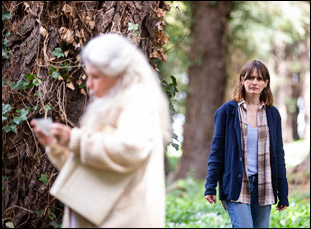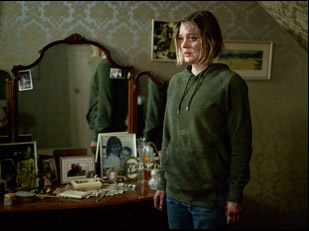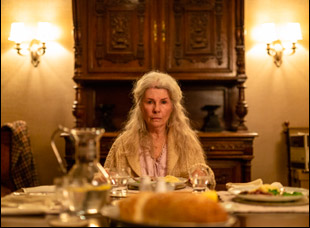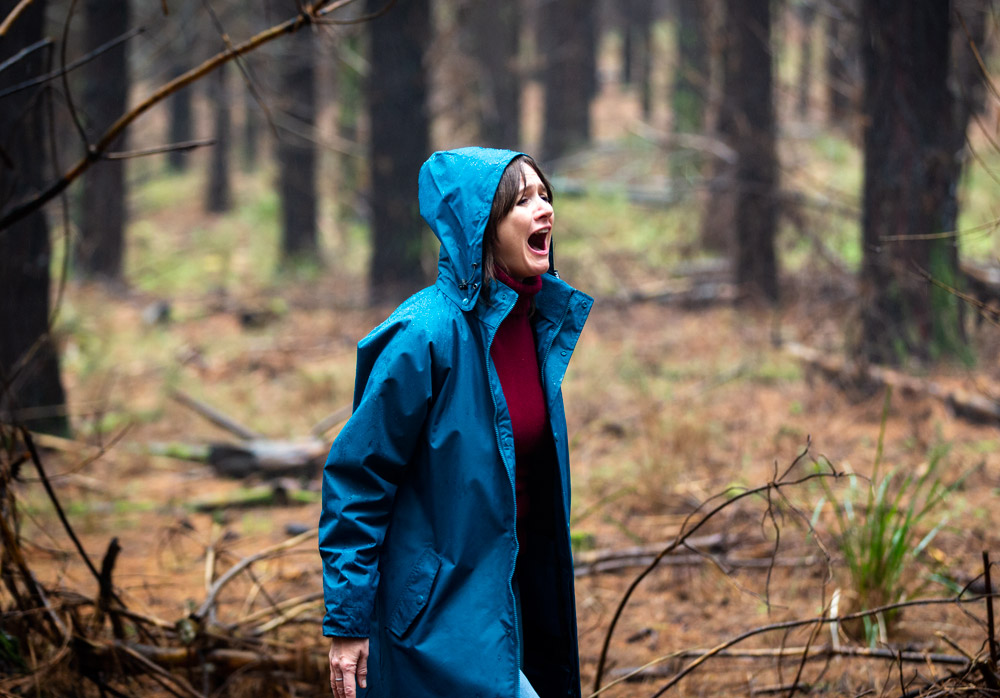It certainly didn’t last for long, but there was a brief moment in time when there was just one person on earth who had the bejeezus scared out of them by “Relic,” and that was when director Natalie Erika James sat down for the film’s premiere at Sundance.
“I’m not good at watching my own work without a critical eye, so I was shitting myself in that first screening,” James says. “I had my partner sitting next to me and I was just gripping his hand so tightly I don’t know how, and my parents were also there – they flew in from Australia, which was wonderful, but it was the first time they were seeing it, so obviously I felt a lot of nerves about their reaction.”
Over the course of 89 minutes, that feeling of dread shifted towards the audience sitting in the Ray Theatre in Park City who were surely shaken by the story of a mother and daughter (Emily Mortimer and Bella Heathcote) traveling back to the home of their gran Edna (Robyn Nevin) as she is caught in the throes of dementia, but equally so in the immaculate skill with which Jones brings it to the screen. Inspired by a trip to see her own grandmother who was suffering from Alzheimer’s in Japan in 2014, the filmmaker had felt the walls closing in on her while spending time in a house that had already spooked her as a child, full of knickknacks that felt sinister when stacked up with no real meaning when she was younger and having elusive conversations with someone who meant so much to her and no longer had the facilities to respond back in kind.
In “Relic,” those psychological dark spots manifest themselves physically at Gran’s place where Mortimer’s Kay and Heathcote’s Sam arrive to find the matriarch has been gone for days, triggering a police investigation, and while she isn’t dead as they feared, she isn’t the person they knew when she comes back, putting more distance in a relationship that’s already strained between Kay and Sam when the two have a difference in opinion about what’s best for her. Shadows feel as if they ensnare the trio when every conversation takes on the weight of the unknown and the familiar items in the house, whether it be a bowl of fruit on the kitchen table or a rumbling washing machine, become disturbingly foreign when the previous context for them is lost in the deepest recesses of Edna’s mind.
For anyone who has witnessed a loved one having their memory pulled away from them, “Relic” will be particularly terrifying, but Jones and co-writer Christian White express the condition so eloquently that anyone is bound to understand as they’re being entertainingly unsettled, and the director who shadowed Leigh Whannell for three months on the set of “Upgrade,” establishes herself alongside him as one of the most exciting filmmakers working in the horror space — or anywhere, for that matter — factoring in her previous shorts “Creswick” and “Drum Wave.” With “Relic” coming to haunt homes everywhere with its release on VOD and digital, Jones graciously took the time to talk about how she crafted such an accomplished debut feature, connecting with her actors to give such emotionally wrenching performances and letting them loose in the house of horrors she created.

It was, and just because I am the granddaughter originally, I would say the film was written more from the granddaughter’s perspective whereas I think Emily’s character Kay is arguably at the center of both relationships, so over time she potentially was given a little bit more screen time. But it was always a granddaughter, mother and daughter. We did have a father character [at one point] as well, but we decided in the end to strip it back and it just felt cleaner in a sense to focus on the three women.
That’s interesting to hear when your earlier short “Creswick” deals with similar themes, but was about the relationship with a father. Was the short helpful in figuring out what this was?
Oh yeah, “Relic,” was kind of reverse-engineered. We had the first draft of “Relic” and we thought very consciously that would make a proof of concept, but tell a much more succinct story that had the same tone, theme and setting, so “Creswick” was great in that it acted a bit as a calling card. We screened it at festivals overseas and it got a bit of attention through that and certainly through chatting with potential producing partners and financiers, it was very handy to have something like that to be able to show thematically, “Here’s what the film is going to feel like. In terms of what I learned, I’m not sure if I can point to one specific element but being able to work with prosthetics and using prosthetics in combination with VFX to heighten that, it was amazing for what we would see later in “Relic.”
Was the house designed with the characters in mind? The character arcs seem to correspond with the physical paths they take.
Yeah, Edna even says in the film “The house is the only thing left “and it serves as such a physical representation of the past and the life that they shared there with Kay as a child, with her now deceased husband, so it serves as a physical representation of those memories, and as the house becomes destroyed and you see the rot and the water damage that’s actually in the house, it definitely serves as an apt metaphor or representation for Edna’s mind, not only her physical mind, but of her memories and the life that was lived there as well.
In designing the house, my production designer Steven Jones-Evans and I talked a lot about the idea of things unseen, so a lot of the spaces will have areas that fall to black or it’s framed in a way where there’s like a wall protruding or a door frame that obscures part of the whole space, so it often feels like there’s something inscrutable in frame. That was mirroring the experience of the three characters and there’s a sense of Edna herself being inscrutable in the same way, so that was certainly a consideration in designing the spaces and then we made sure that the lighting worked to enhance that.

Yeah, you definitely find a lot of sounds in post, but there were certainly elements that we talked about in preproduction and even before that we were really conscious of needing to find the right sound. With the house, there’s a certain breathing sound, which is like an aural motif throughout the film and that was a slowed-down heartbeat, so we had that very early on and probably the death rattle at the end of the film was one that we knew we had to be really considered. We went through all sorts of iterations, trying anything from the combination of a tiger’s roar or purring and in the end, it was the combination of many different things, one of which was our sound designer’s assistant had a cold and breathing through the flem in his chest created the perfect sound. [laughs]
Given the theme of estrangement within this family, but their care for each other comes through – how did you get that feeling on set for the actors?
A lot of the preparation was in discussions that we had throughout the shoot, but also prior to starting the shoot where you chat through the script with the actors, but also talking about our life experiences. It’s not dissimilar to co-writing with someone in that you’re just really sharing the emotional discoveries or the emotional experiences that you have and then you start to build a language around those things. You start to find common ground between both of your life experiences and in that way, then you can talk about it on set in a way that makes sense to both of you because if I say a terrible [vague] thing like, “I just need it to be more sad” [on set], that could mean a thousand different things unless you have a shorthand between you and the actors to point to to give them some motivation to strive for in a way that resonates with them.

So fun. I’ve never done this amount of stunts before, but I really fell in love with the whole process. We worked with an amazing stunt team as well, which was headed by a female stunt coordinator, which was great, so it was an all-female exercise and we did a lot of rehearsals for the stunts. But it did feel like there was an element of chance – not in safety, of course, but in terms of how it all came together. As a smaller indie film, we didn’t have quite as much rehearsal time as a much bigger studio film, so I just remember walking up on the day of the altercation at the end of the film and I felt like it was a little bit underrehearsed and we just walked up an hour early and stepped through it. The mechanisms were all plotted out, but there are still things you find on the day that help you, so it was a really fun process and all three of them were so game, but when Robyn is in her mid-seventies, she was just particularly gung ho from the get-go.
Obviously, you had a wealth of experience behind the camera before this, but what was it like being on the set of your first feature?
I was so happy. You work so hard to get to a certain point in your career where you can make your first film. It’s such a goal for such a long time and there’s always this fear that it’s not going to be as good as you want it to be or you get there and it’s like not what you want, whereas I was like, “This is definitely what I want to do for the rest of my life.” That was definitely a gratifying feeling to have and in terms of the all the pressures and the scale of it, in some ways you have to separate that side of your brain in a way. You have to push those thoughts aside. There’s enough going on on set that it does feel surreal in some ways, but it also feels like everything you’ve been training to do for 10 years and it just feels like a normal set, which is great.
“Relic” is now available on digital, including iTunes and Amazon, and demand as well as select drive-in locations.




